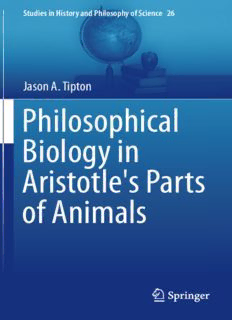
Philosophical Biology in Aristotle's Parts of Animals PDF
Preview Philosophical Biology in Aristotle's Parts of Animals
Studies in History and Philosophy of Science 26 Jason A. Tipton Philosophical Biology in Aristotle's Parts of Animals Philosophical Biology in Aristotle’s Parts of Animals STUDIESIN HISTORY AND PHILOSOPHY OFSCIENCE VOLUME26 GeneralEditor: STEPHENGAUKROGER,UniversityofSydney EditorialAdvisoryBoard: RACHELANKENY,UniversityofAdelaide PETERANSTEY,UniversityofOtago,NewZealand STEVENFRENCH,UniversityofLeeds OFERGAL,UniversityofSydney NICHOLASRASMUSSEN,UniversityofNewSouthWales JOHNSCHUSTER,UniversityofNSW/UniversityofSydney KOENVERMEIR,CentreNationaldelaRechercheScientifique,Paris RICHARDYEO,GriffithUniversity Forfurthervolumes: http://www.springer.com/series/5671 Jason A. Tipton Philosophical Biology in Aristotle’s Parts of Animals 123 JasonA.Tipton St.John’sCollege Annapolis,MD,USA ISSN0929-6425 ISBN978-3-319-01420-3 ISBN978-3-319-01421-0(eBook) DOI10.1007/978-3-319-01421-0 SpringerChamHeidelbergNewYorkDordrechtLondon LibraryofCongressControlNumber:2013951184 ©SpringerInternationalPublishingSwitzerland2014 Thisworkissubjecttocopyright.AllrightsarereservedbythePublisher,whetherthewholeorpartof thematerialisconcerned,specificallytherightsoftranslation,reprinting,reuseofillustrations,recitation, broadcasting,reproductiononmicrofilmsorinanyotherphysicalway,andtransmissionorinformation storageandretrieval,electronicadaptation,computersoftware,orbysimilarordissimilarmethodology nowknownorhereafterdeveloped.Exemptedfromthislegalreservationarebriefexcerptsinconnection with reviews or scholarly analysis or material supplied specifically for the purpose of being entered and executed on a computer system, for exclusive use by the purchaser of the work. Duplication of this publication or parts thereof is permitted only under the provisions of the Copyright Law of the Publisher’slocation,initscurrentversion,andpermissionforusemustalwaysbeobtainedfromSpringer. PermissionsforusemaybeobtainedthroughRightsLinkattheCopyrightClearanceCenter.Violations areliabletoprosecutionundertherespectiveCopyrightLaw. Theuseofgeneraldescriptivenames,registerednames,trademarks,servicemarks,etc.inthispublication doesnotimply,evenintheabsenceofaspecificstatement,thatsuchnamesareexemptfromtherelevant protectivelawsandregulationsandthereforefreeforgeneraluse. While the advice and information in this book are believed to be true and accurate at the date of publication,neithertheauthorsnortheeditorsnorthepublishercanacceptanylegalresponsibilityfor anyerrorsoromissionsthatmaybemade.Thepublishermakesnowarranty,expressorimplied,with respecttothematerialcontainedherein. Printedonacid-freepaper SpringerispartofSpringerScience+BusinessMedia(www.springer.com) Preface Ifmylifeweretwo dimensional,thisbookwouldhaveseen thelightofdayyears ago.IamsogratefultomywifeLizandourchildren,ZachandNora,foraddinga thirddimension.TherehavebeenmanytimeswhenLizwatchedfromtheshoreas Ispentcountlesshourstryingtocatchsomenondescriptfishaspartoftheworkthat went into this book. She has been extremelygood-naturedas I have tried to coax ourchildrenintosuchmadpursuits. v Acknowledgments Theseedsofthisbookweresownintheofficeofmymentor,RonnaBurger.Given myinterestinbiology,shecouldnotunderstandwhyIevencontemplatedworking onPlato asa dissertationproject,asIhaddoneformymaster’sthesis. Inaturally belonged among Aristotle’s more biological works. Ronna not only gave me that initialpushbutchallengedmythinkingateverystep.Hergentleinfluenceisclear tomeinmostofwhatishere. IamalsoparticularlygratefultomycompatriotsinphilosophicalstudyatTulane University—StevenBerg,MichaelGolluber,andMattOberrieder.HenryBart,my advisor in Tulane University’s Ecology and Evolutionary Biology Department, helped further my love of the biological world, especially the world of fishes. ConversationswithcolleaguesandstudentsatSt.John’sCollege,Annapolis,helped sharpenmythinkingaboutAristotle. I was very fortunate to receive a Fulbright Fellowship to Greece during the 2000–2001academicyearasthisprojectwascomingintofocusforme.Inaddition, Sherry Fox and the Wiener Lab at the American School of Classical Studies in Athens (ASCSA) helped in many ways as I attempted to follow Aristotle. The ASCSA, a place more frequently populated with archaeologists and classicists, provided a warm welcome to me and is the source of many fond memories. The people of Lesvos, Greece, offered help and advice at many junctures. Among the Lesvians, Hjalmar Dahm and Georgios Sitaras offered invaluable logistical assistanceandfieldhelp. vii Contents 1 Aristotle’sPhilosophyandBiology:TheBiologicalPhenomena ....... 1 1.1 TheBiologicalPhenomena............................................ 2 1.2 Aristotle’s“Pre-Socraticism”......................................... 10 2 TheProblemofBeginnings(PAI.1) ....................................... 19 2.1 TheDivisionsofKnowledge.......................................... 20 2.2 ThreeProblemsConcerningMethodology........................... 21 2.3 ThePhainomena....................................................... 28 2.4 TheAncientsandTheirCausalAccounts:MaterialCause.......... 30 2.5 EfficientCause......................................................... 32 2.6 ErgonandFormalCause .............................................. 33 2.7 Soul,ErgonandNature................................................ 35 2.8 IntellectandMotion................................................... 37 2.9 NatureDoesEverythingforaPurpose ............................... 38 2.10 TeleologyandNature.................................................. 40 3 RecognizingSamenessandOthernessinAnimals(PAI.2–5)........... 47 3.1 DichotomousDivision................................................. 50 3.2 Nonbeing............................................................... 56 3.3 TheIndivisibleSpeciesofBeing(eidostitêsousiasatomon) ...... 58 3.4 DividingbyOusia ..................................................... 60 3.5 CommonFunctionsofBodyandSoul................................ 60 3.6 The Discontinuity of Dichotomous Division; OrthePart/WholeRelationshipinDiscourse........................ 62 3.7 PlaitingandDividing.................................................. 63 3.8 SwimmersandFliersRevisited....................................... 64 3.9 BeingsandImmediateForms......................................... 66 3.10 BringingtheGodsDownIntotheInquiry............................ 67 3.11 ANewTurninDivision............................................... 69 ix
Description: